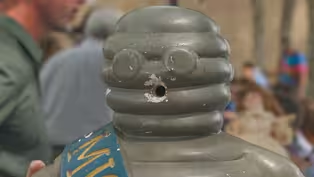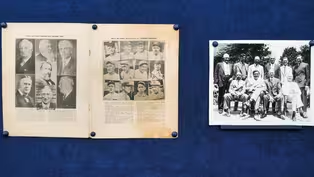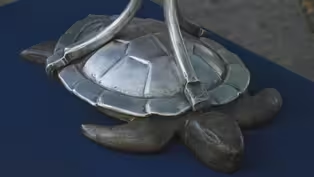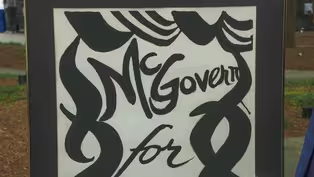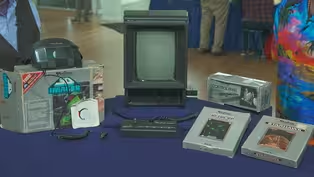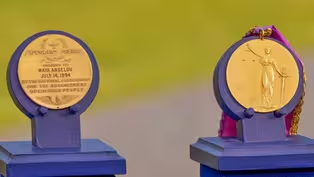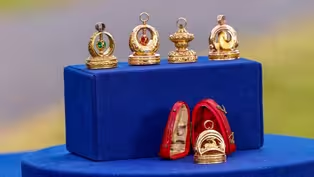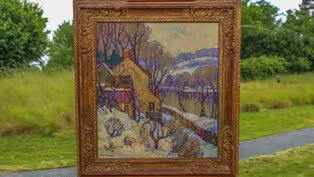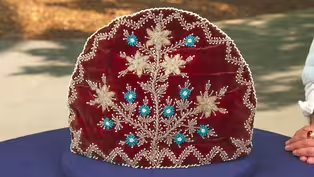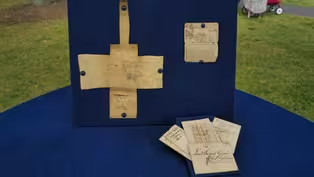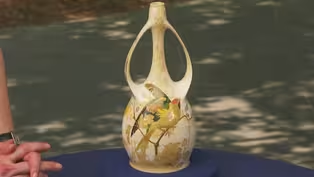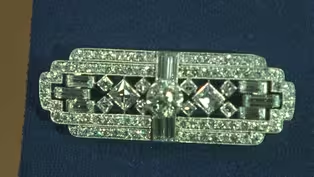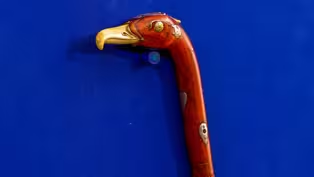
North Carolina Museum of Art, Hour 1
Season 28 Episode 10 | 52m 24sVideo has Closed Captions
ROADSHOW heads to Raleigh in search of treasures at the North Carolina Museum of Art!
ROADSHOW heads to Raleigh in search of treasures, including 1994 Maya Angelou Spingarn Awards, a 1939 autographed Baseball Hall of Fame program and a Le Pho La Cueillette des Pommes Cannelle oil, ca. 1950. One is $60,000 to $100,000!
Problems playing video? | Closed Captioning Feedback
Problems playing video? | Closed Captioning Feedback
Funding for ANTIQUES ROADSHOW is provided by Ancestry and American Cruise Lines. Additional funding is provided by public television viewers.

North Carolina Museum of Art, Hour 1
Season 28 Episode 10 | 52m 24sVideo has Closed Captions
ROADSHOW heads to Raleigh in search of treasures, including 1994 Maya Angelou Spingarn Awards, a 1939 autographed Baseball Hall of Fame program and a Le Pho La Cueillette des Pommes Cannelle oil, ca. 1950. One is $60,000 to $100,000!
Problems playing video? | Closed Captioning Feedback
How to Watch Antiques Roadshow
Antiques Roadshow is available to stream on pbs.org and the free PBS App, available on iPhone, Apple TV, Android TV, Android smartphones, Amazon Fire TV, Amazon Fire Tablet, Roku, Samsung Smart TV, and Vizio.
Buy Now
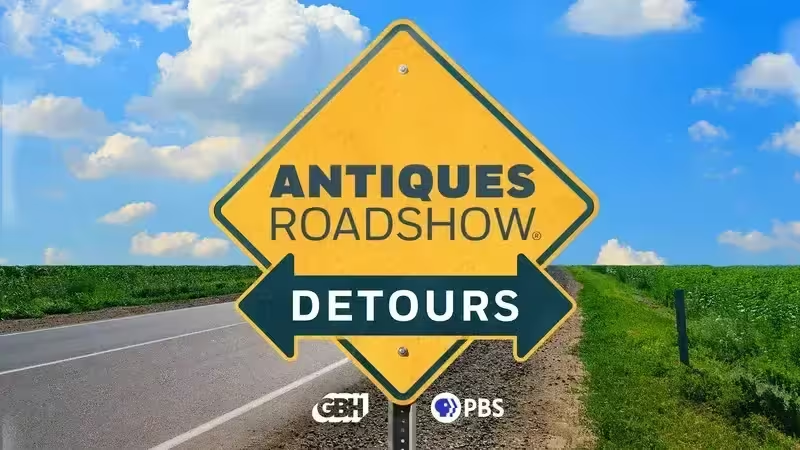
ANTIQUES ROADSHOW DETOURS
Ever wondered what happens to the treasures featured on America’s beloved ANTIQUES ROADSHOW after the cameras leave town? Host Adam Monahan tracks down the juicy afterlives of your favorite finds from PBS’s hit series.Providing Support for PBS.org
Learn Moreabout PBS online sponsorship♪ ♪ CORAL PEÑA: It's a great day for "Antiques Roadshow" to discover treasures in Raleigh, North Carolina.
My mother admired this and...
Put it in her purse.
(laughs): Yeah, just about!
Wow.
APPRAISER: Yeah.
That's amazing.
♪ ♪ PEÑA: The North Carolina Museum of Art is the repository of the state's public art collection, with works that were created over a span of more than 5,000 years.
The origin of the institution goes back to the 1920s, with the formation of the North Carolina State Art Society, which helped develop an interest in creating an art museum for the state.
Later, in 1947, the state legislature approved $1 million for the purchase of art for the people of North Carolina, while generous donors' contributions greatly added to the cause.
Fast-forward to today, where "Roadshow" has set up at the Museum Park, a perfect marriage of art and nature open to the public with reflecting pools, gardens, and, of course, cherished cultural assets, like the gigantic work "Ogromna" by Ursula von Rydingsvard.
"Roadshow" is ready for art-loving people from all over North Carolina and beyond.
What did they bring?
Let's see.
♪ ♪ Sometimes they have linings in them.
Um, these were never meant to have linings.
MAN: What can you tell me about this?
GUEST: Uh, I've been told it may be a fishbowl, um, but I'm not entirely certain.
MAN: How do you use it?
Uh... Just drink out of it.
Well, so far I've...
I've just been, um, transporting it around, uh, ultimately to this location.
GUEST: I served on Senator McGovern's staff for several years.
One day, he opened up his vault and invited the staff to come in to choose various things if they were so interested in them.
And I found this.
And I said, "Senator McGovern, may I have this Calder poster?"
And he said, "Well, sure."
For many years, it remained in the closet because my late wife didn't like it.
Even though she also worked for McGovern... (chuckles) Oh, right?
(laughs) ...she did not like it.
And then unfortunately, she passed in 2014.
But a year later, I said, "Honey, it's going on the wall."
I'm very proud of it, uh, 'cause it reminds me of my affiliation with, with, uh, the late senator, and, uh, which was a grand experience.
But I've never known anything else about it other than Alexander Calder did it.
McGovern, of course, was the senator from South Dakota who ran against Richard Nixon in 1972.
Correct.
Doomed, doomed race.
Doomed race, doomed race.
Nixon won by a landslide, two-third majority... You've... McGovern... We carried Massachusetts and the District of Columbia.
I feel like I'm, I'm, I'm teaching my professor here.
(both laugh) McGovern, of course, ran on a anti-Vietnam War ticket.
Nixon, not so.
Calder, we know, was also vehemently against the Vietnam War, and worked on this as a contribution to the campaign.
And these lithographs, which were done in a limited edition, were sold to raise funds for the McGovern campaign.
Calder would make watercolor gouaches of these designs, which were then printed as lithographs.
I actually know who did the printmaking... Hm.
...and the work with Calder, 'cause it was my father-in-law.
You're kidding.
His name was George Goodstadt.
He's no longer with us today.
(laughs) But I have a close connection to these, too, just as you do with McGovern.
My, my father-in-law was, was the printmaker working with Calder on these.
That's unbelievable.
And then they were published by an outfit in New York called Styria Studios, and you can see the blind stamp... Mm-hmm, mm-hmm.
...for Styria down there, and signed by the artist.
All of them were made in an edition of 200.
This one says "McGovern for Government."
There are other versions in color, also black and white, that say "McGovern for McGovernment."
Had no idea.
And Calder's telltale, very characteristic geometric designs around them.
Yes, yes.
So it does scream out at you as a Calder.
They're popular on, on different levels, because of the historical nature of them, which you don't get with a lot of Calder's art, and what that campaign stood for.
Mm-hmm.
And also for just the artistry of what Calder did for a promotional poster, if you will.
A lithograph poster.
Yes.
Yours looks like it's in great shape.
Overall, it looks very much like it probably did when you got it out of the, the closet... Sure does.
...in, in McGovern's office in... (chuckles) So have you ever had it valued?
Never.
I would put a replacement value on this at around $5,000.
Well, I'm, I, I do cherish it, and will continue to do so.
GUEST: This is the day the Hall of Fame opened in Cooperstown, New York, on June 12, 1939.
And my grandfather was there.
He rode the train from New York City on that day.
It was called the Cavalcade of Baseball.
He got the majority of the original inductees' autographs there that day.
He told me when I was probably ten years old that he hid in the bathroom after the Old-Timers' Game or the All-Star Game that day.
And as they were having the reception, he, I guess he came out of the bathroom and everybody was there.
All these greats of baseball at the time were in the reception hall, and he, that's where he got everybody's autograph.
That would've been an impressive room to be in.
Country's coming out of the Depression.
This meant a lot.
College football and baseball.
Right.
That's, that's what it was all about back then.
You've got heroes, you've got titans, you've got guys retiring.
Now how are we going to celebrate 'em?
Oh, I got it, we'll enshrine them.
Whose autograph did he get?
Well, I guess the most famous one that everybody knows is Babe Ruth.
Then there's Walter Johnson, and there's Honus Wagner.
And there's Cy Young and Connie Mack.
And there's Larry Lajoie and there's Tris Speaker, and...
But he never got Ty Cobb's autograph.
He wasn't there yet, in that famous picture right here.
Ty Cobb's not in that picture.
I think as far as autographs go, he's got 80% of them, of those guys right there.
It's a large program, and you had some other signers.
They simply weren't as significant as these guys.
Everything there is to see and all the autographs there are to have-- but Ty Cobb-- are on this page.
Really strong autographs, it's a delicate piece.
There's age-induced wear and toning, the kind of thing you expect.
How'd your grandfather come to possess the photo?
Actually, later years, I found out about the photo, and I acquired it.
What we have here is just a nice image of all the men sitting there that day, enjoying being enshrined, being beloved.
You familiar with who's on here?
Babe Ruth's in the middle, and, and that's Connie Mack sitting beside Babe Ruth.
That's... What's funny is, they, they made Honus stand, he's, he's over on the far left, standing, staring menacingly at Ruth.
"Hey, you got my, you got my seat, kid."
(laughs) Um, yeah, there's Ruth in the middle, next to Connie Mack.
And you got Walter Johnson standing on the far right, as well-- it's a who's who.
(laughing) It's a great photo, not original.
No.
But it's a nice showpiece.
It is, it is.
On its own, not a lot of value, couple bucks.
Right, right.
I want to poke fun at you for shellacking this page, and I don't want to name names and who did what.
It's not the worst thing you could have done, certainly fire would have been worse, uh, but, uh, we, we weren't a fan of the shellacking.
Uh, but that said, it really hasn't ruined the autographs.
(chuckles): In fact, it may have served to preserve at least the Babe Ruth autograph.
Uh, you know, moving forward, no more shellacking.
(laughing): Okay.
That was Granddad, not me.
(laughs) I love the story.
I love the "Mission: Impossible"...
I love that he, that he did everything he could.
How, how old was he?
Uh, at the time?
Uh, Granddad?
Oh, he's probably 35.
Okay.
(laughing): So this is a grown man... Yeah, yeah.
...who's just going to steal away... (both laughing) ...to go get some autographs, I love that.
Right.
Value.
An auction estimate we think a, appropriate for this piece, with all of the autographs-- we're talking about the Centennial, 1939 Cooperstown program-- we think an auction estimate, appropriately, is at $10,000 to $20,000.
Right.
Okay?
Insurance-wise, we think a proper insurance value for this is $50,000.
Interesting.
Okay?
Yeah.
Uh, well, Granddad, this was his, uh, crown jewel.
He loved-- he knew he had something special, and he, he loved sharing the stories with us.
GUEST: My aunt, uh, was an antiques dealer, and when she passed away, she left this to us.
And I don't know if it's of any value, but I figure if she was an antiques dealer and she kept it for herself, it might have some value.
I'm assuming that the parrot is eating the rose.
(laughing): And the dogs are interested in stealing its rose.
GUEST: Well, I brought a pin in that is stamped "Tiffany," and it is full of diamonds, and I believe it's platinum.
I, um, purchased it about 30 years ago, and I tucked it away and brought it out yesterday.
(chuckles) So it really hasn't seen daylight?
Not, n, not, no, not really.
Did you acquire this from a private individual or from a store?
Yes, from a private individual.
And they had heard that I like old pieces...
Okay.
...that were really nice, and she brought it to me, and we agreed on a price, and I, and I purchased it.
Okay, fantastic.
And you paid how much for this piece?
I paid, I think, right at $3,000.
Okay.
Mm-hmm.
Well, I think that that was an excellent investment.
Mm-hmm.
The item is made by Tiffany and Company.
Mm-hmm.
We have a, a clear mark on that.
This is a quintessential Art Deco jewel.
Mm-hmm.
I absolutely am in love with this because of the lines.
Mm-hmm.
You might expect me to say the diamonds first, but truthfully, it's got these beautiful Art Moderne lines that are just captivating.
You have diamonds in a variety of shapes.
There's the European-cut diamond in the center.
You have French-cut diamonds, baguette-cut diamonds.
There are round-cuts.
They're all set in a beautiful platinum frame.
This is magnificent Art Deco craftsmanship in a very Art Moderne style, with brilliant lines.
This is sculpture in miniature.
Good.
And it just makes everybody catch their breath.
This is a treasure.
Mm-hmm.
It should be worn.
I knew I liked it.
If you were to go to a high-end retail store today, you could look at $25,000 to $30,000...
Okay.
...for this piece.
Okay.
So your thir, your $3,000 investment was money well spent.
Well, that's not too bad.
Yeah, no, I think so, too-- it's awesome.
(laughs) I am, I am happy that I purchased it, and, and I appreciate the craftsmanship in it.
So I guess I'll have to wear it from now on, yeah.
You should.
PEÑA: This beautifully carved marble casket has a story any Roadie can appreciate: a story of mistaken identity.
After spending several decades as a planter in a residential Greensboro garden, a discerning family member thought it warranted professional research.
Lo and behold, it turned out it was an osteotheke from the second century: an ancient Roman container for bones, not geraniums.
GUEST: So I brought a painting that belonged to my grandparents.
It hung in their home, it hung in my mother's, my parents' home, and it's been hanging in my living room for the past 20 years.
I know it's Fern Coppedge.
Mm-hmm.
And, um, Lehigh Valley, Delaware Gap area is the scenes that inspired it.
The painting had been purchased by my grandparents, my father's father, and we believe they purchased it at a auction or fundraiser for Lafayette College, which is also in Eastern Pennsylvania.
I did notice a price tag and a t, with a title that says, uh, "December Mist," uh, "$100."
Fern Coppedge is one of the best-known Pennsylvania Impressionists, so you have here one of her quintessential works.
Wow.
Um, and when I say quintessential, I think it has everything that you want in a, in a Fern Coppedge.
Oh, really?
'Cause I always thought it was dark, so...
I think it's gotten a little dark with age.
(laughs): Okay.
This would have been painted probably early o, early on when she came to Pennsylvania.
So she came to Pennsylvania in 1920 to live and work in Bucks County and in Philadelphia.
Before that, she studied at the Art Institute of Chicago and at the Art Students League with, uh, William Merritt Chase... Oh, wow.
...in New York, and then at the Pennsylvania Academy of Fine Arts with Daniel Garber.
Approximately when do you think the painting was, was purchased?
Probably 1920s, 1930s.
And it does make sense with Fern Coppedge's own movements into, uh, Pennsylvania, because she actually started to settle down in Pennsylvania i, as of 1920.
She was a lover of light and color.
Given the fact that this is, painting is from 1920, that makes it ba, basically about 100 years old.
Yes.
And there's a lot of dirt, uh, that has settled into the paint.
But even through that dirt, we can see the amount of attention she paid to color.
When we look at the snow, especially, she saw so many different colors within the snow that would change with the time of day.
She took one step towards Fauvism, expressing the emotions, colors expressing the impressions, as well.
And I think if the painting was cleaned, a lot of these blues would just pop out dramatically.
Oh, really?
Uh-huh.
And the purples would also pop out.
This painting is oil on canvas.
So I assume it's the original frame.
I do think it's the original frame, yes.
Mm-hmm.
This is the typical kind of subject matter that she loved.
She loved the snow.
She would even go out and paint in a, like, a, in a bear skin.
She would paint en plein air, which means paint outside.
Right.
She was very much into the reality of the moment.
The group of, uh, female artists with whom she was associated was called the Philadelphia Ten.
It was a group of progressive fe, uh, female artists who basically supported each other in the otherwise kind of boys' club of artists during that time.
Uh, they would exhibit together and work together from the 1920s into the 1930s.
She exhibited widely during, during the time, and she was respected even though women artists didn't have as much visibility, I would say, as some of the major male artists like, uh, Redfield and Garber, who was her teacher and, and one of her, uh, closest artist friends.
It really celebrates everything that she saw.
She would even tie her canvases up in between trees, uh, to... Oh, really?
Yeah.
Wow.
So she was intrepid.
Her market has been doing very well recently.
Oh.
I would insure this for no less than $120,000.
Oh, really?
(laughs) Wow, wow.
Okay, that's, that's worth insuring.
(laughs) I was not expecting that.
Thank you, Grandpa.
(both laugh) It's some weird art glass vase I found at Goodwill for five dollars.
It's covered in kitchen grease.
Just, it reminds me of a weird sea urchin, and I love it.
(laughing): It's kind of ugly, but in the best way.
It's a video game system called Vectrex, which I believe is from 1982.
So in the early '80s, my parents built a retirement home on the far eastern tip of the North Fork of Long Island.
No cable TV, before internet.
My mom, who had worked at the Gimbels department store, wanted there to be something in the house for the kids, and she bought this.
You could not ask for, like, a more niche, specific part of video game history.
So you are correct in that it is the Vectrex system.
It uses a vector display, which, a vector display utilizes drawn lines instead of pixels.
Right now, I could already feel the collector cravings watching this segment.
They're very tough to come by, very tough to find with the games.
But the pièce de résistance that you have over here is the 3D Imager.
Now, that my mom didn't buy.
I had it just boxed away.
And when I started to get reinterested, I realized that there was an accessory of some importance that was missing.
And I bought this online in 2011.
Do you remember what you paid for it in 2011?
$615.
You made a positive investment buying that in 2011.
And if you were curious, before we jump to that, though, what your mother would have paid for this in 1982 would have been $199.
That was the retail cost of a Vectrex back then.
Ah.
That sounds like a lot for '82.
It is a lot.
That's equivalent to over $500 today.
Right.
The 3D Imager, such a cool video game accessory.
But the reason why in particular it is so rare is that in 1983, the video game world was turned upside down.
Literally, it's the video game crash of 1983.
And unfortunately, the Vectrex fell right at that time period.
Ah.
There was such an oversaturation of video games.
There were so many consoles, there were so many developers.
There was too much for the market.
So it's like the process of natural selection.
Only the greatest few could survive.
The 3D Imager, only three games were ever released for, to be used with the 3D Imager on the Vectrex system.
The Imager was released early 1984.
By the time the Imager was hitting the store shelves, the system was already failing and becoming a market flop.
Had, had no clue.
Today's market, the Imager alone is a $2,000 to $3,000 accessory.
(chuckles) Mo, Mom would be happy.
Yeah, Mom did a great job, because the whole package today, at auction, everything here, easily going to be $3,500 to $4,000.
You're the first person to take this out of the box.
I didn't even take it out of the box when I bought it.
Well, guess what?
I'm also going to be the first person to try this on right now.
Because I can't even imagine playing a game with this back in the day.
(chuckling) And using-- there's a color wheel in here that spins super-fast.
I see-- I see it.
(laughing) Here's the color wheel right here.
And you would have to change the color wheel depending on what game you would be playing.
All right, so you ready to turn it on?
Let's do it.
Look at the home screen!
1982.
(chuckling) Unbelievable.
It's the last thing I would have ever expected... Mm-hmm.
...to see here today.
GUEST: One of our dear friends, they were having an estate sale, and she had a lot of things from her grandparents.
And my husband, he loves antiques, collectibles, so I called him over, and he immediately gravitated to this Michelin Man and, um, wanted it right away.
I don't remember what my husband paid.
I love this character-- he's one of the great advertising characters of the 20th century.
His name is Bibendum.
In 1894, the Michelin brothers had a show.
They saw a stack of tires, and they said it looked like a man without arms.
They got, went to a cartoonist, and they created this character, Bibendum.
He shows up in plaster and in papier-mâché.
He shows up in cast irons.
Now, this is the painted plaster, which I think is a little later.
'20s and '30s?
It's really hard to know exactly when what was made.
One about two years ago was, I think, repainted.
It was all yellow.
Yes.
Beautifully painted.
Yes, sir.
It brought, um, $4,500.
Wow.
Then a year or two before that, one brought, which was gray paint, like this, which is the best of the best of the best, and I wouldn't worry about the-- was, like, $6,500.
I think this is about $7,500.
Hear that, Susan?
Write that down.
And I just think it's absolutely phenomenal.
PEÑA: Some things never change, like the love of chocolate.
This gorgeous example of a Mayan vessel was used by the ruling elite for drinking chocolate beverages.
The vase includes a date in the Mayan calendar which corresponds to our Gregorian calendar as December 5, 711 C.E.
It likely survived because it was preserved in a tomb for over a thousand years.
GUEST: About eight years ago, I had the pleasure of meeting Maya Angelou, and...
I just fell in love with her from my time when I knew of her back in my college years for her poem "Phenomenal Woman."
And my wife's a huge fan of hers.
And I met her in Winston-Salem.
And unfortunately, she passed away not too long after I met her.
They had a auction of her estate in Kernersville, North Carolina.
I didn't even know she was a North Carolina resident.
And she had told me how she lived in North Carolina, and she worked at, uh, Wake Forest University.
And so I went through the pre-auction guide, and I saw these.
The name of the award is the Spingarn award.
Well, my mom went to Spingarn High School in Washington, D.C. She was the first graduating class.
So I said, "Hmm, that's interesting."
So I delved even deeper, and the first recipient of this w, award was my fraternity's founder, Dr. Ernest Everett Just.
So the connection even, grew even more.
This one is ten-karat gold.
And, and I looked at who won this award, and it's a prominent award given by the NAACP to African Americans.
Oprah Winfrey has one, Sidney Poitier has one.
Martin Luther King has one.
Harry Belafonte has one.
Very, very many.
Jackie Robinson.
Jackie Robinson.
Hank Aaron.
Hank Aaron.
The list goes on-- yeah.
Paul Robeson, also.
So I said, "I've got to have this."
And so, uh, my friend went to the auction, and I was supposed to go, but my father had gotten sick.
And so I got on the phone, and I was really willing to go as high as I had to go to get this.
I thought it was going to go for at least $5,000, but it didn't.
It went for around gold price, which was $1,100.
Now, I had forgotten about this one.
So what I found out was, they give two awards, they give one that the recipient walks around with.
Right.
And in case it gets snatched or gets stolen or something like that, or lost, you still have the real one.
So my friend who was at the auction, he purchased this for me for $80.
My 50th birthday came along, and he presented this to me-- I already had this one.
I did find another auction record of a walk-around selling.
Wow.
Uh, and surprisingly enough, it brought $3,000.
Wow.
So, you know, for an auction estimate on the walk-around... Wow.
...about $3,000 to $5,000.
Wow, for the walk-around?
For the walk-around.
(laughs): Okay.
Now, you said... That's pleasantly surprising.
Y, y... That's a good surprise.
You said you spent $1,100 on...
Yes.
...that piece, and that was the gold value.
Yeah, yeah.
Well, good news is, gold has gone up.
Absolutely.
And the gold value on that piece now is over $2,000.
Yes.
But that's peanuts compared to what I think it's really worth.
An important award-- I wouldn't be surprised to see it go in the $20,000 to $30,000 range.
(breathily): Wow, wow.
Uh, I think that would be a, a fairly conservative estimate, and I wouldn't be surprised to see it explode even higher.
Well, that's great to hear-- I, I wouldn't...
It's something I won't sell.
But I, I'm proud to be the guardian of it.
But, um, it's great to know that it has a value, and I'm, I'm just happy to have it, and, and I'm happy to have this piece of African American history.
And if you're keeping it, which is the plan... Mm-hmm.
...then you probably want to insure it.
Yup.
I will now.
Um, something...
I would probably want you to insure it for around $50,000 to protect yourself.
Wow.
It's a whirligig.
It's made by Vollis Simpson, the same artist who did the big whirligig out there in the pasture.
And, uh, we bought it directly from him.
I paid $300.
My son asked him, "What is your process?"
He said, "Well, first you got to know how to do it, and then you do it."
(laughing) GUEST: I'm hoping it's a woodblock print.
APPRAISER: Mm-hmm?
A friend of mine gave me, or let me choose, two.
And these prints were given to her by her aunt, who had a friend that had a friend that worked in the embassy during World War II.
Ah.
So they were exchanged, I, we were told, for food, medicines, or whatever.
Yeah, yeah.
She was given a, a, a fairly good-sized stack of all kinds.
Mm-hmm.
And she told me I could pick two.
And this was my favorite.
Oh, you did well.
Oh, good.
(both laugh) So, you know what it is?
I think it's a woodblock.
Yes, it is.
A woodblock print.
I'm hoping-- that's what we were told.
Yes, woodblock print.
Okay.
But, uh, um, not traditional one.
It's an early 20th century... Ooh.
...called sosaku-hanga.
So the, uh, artist, Kotondo, is very famous.
Okay.
And all the print collectors like him.
His, um, last name was Torii.
Okay.
And he's, um, famous, um, maker, famous, uh, printmaker, making, uh, posters for kabuki.
Also, uh, he did bijin-ga, meaning "beautiful women prints."
It's very popular.
That's where this comes from, yeah, okay.
Yes, and he worked in Tokyo.
And it's signed here, Kotondo.
Here-- it says its artist's name and the artist's name in a seal.
It's dated Showa, Showa-- fourth of Showa.
So that's around 1930s.
Okay.
And she's combing her hair, actually, right?
Yeah.
You can see.
Yeah, long hair.
Yes, yeah, long hair.
So the title is, it's embossed.
Oh!
Yes, it is!
Can you see?
I see, I never saw that before.
Says "Kamisuki," meaning, uh, "Combing Hair."
Huh?
Wonderful, yes.
Never saw that.
Yes.
And I called it "The Girl With a Comb."
When they do a block, it's not one.
You have to make several.
Oh.
You have to do the key block, which is just black outline, and then you have to do red, the lips, and yellow for the comb.
Jeez.
You see?
So you probably have to do four, five different blocks.
Oh, wow.
Japanese prints are not numbered, yeah.
Oh, okay.
But they probably made about 200.
So, yeah, I have seen this, it's one of my favorite.
Oh, you're kidding.
So I was surprised to see it in, uh...
I have looked, I have gone on the computer.
I have never found it.
Oh, you haven't?
Yeah, okay.
No, never saw it before, again.
Oh, I see.
Yes, and you probably wonder how much that would be, 'cause you didn't pay for it, right?
You picked.
(chuckles) What do you think?
$500?
(laughs): No, much more.
Ooh.
(laughing): Yeah.
No, no... Um, I think in a shop, they could go for...
It's a good condition, so it could go for maybe $4,000?
(gasps): Oh, my gosh!
(laughs) No!
On a good day, $5,000 or more.
No idea-- none.
Yeah, yes, yeah, yeah.
Wow.
But anyway, if you wait, the, the market is very good for these Japanese prints, so it might go up in prices.
Wow.
So I'll see you in five years.
(both laugh) Yeah, oh, that's exciting.
Isn't that?
GUEST: Well, today I brought some musical pocket watch fobs.
Um, normally, gentlemen that wore pocket watches would wear fobs or seals on the other end of the, their chains, but these, um, all five of these actually have a musical movement underneath it, and each one of them plays a separate tune.
You just turn the top, and there's a small switch in the front, and the watch owner could listen to the tune.
I started collecting regular watch fobs, and when I was on travel for work, a young lady in the U.K. showed me this one.
Uh-huh.
And as soon as I saw it, I was hooked.
So this has taken me about ten or 12 years to collect.
What did you pay for them?
This one was about $900 to $950.
Um, this was under $2,000, more like $1,900.
This one was just at $2,000.
Um, this one was around $2,100.
And this one was a little bit more expensive, because it has the original Moroccan leather case... Uh-huh.
...and it was just a touch over $4,000.
Oh, okay, very good.
Well, they're really fantastic.
When you brought 'em to the table, I was immediately engrossed in them.
(laughs) They're from the early to mid-1800s.
They're a great collection of watch fobs, and they're musical.
Yes.
And they play a beautiful little tune.
Would you like to hear one?
Yes, we would love to hear one.
Certainly.
So you just turn the stem on the top.
(fob whirring, tune tinkling) That extra added element of the playing the music is just amazing.
Absolutely fascinating to me.
So have you ever had anybody currently appraise them?
I have not.
I have not.
And so how long ago did you, were you buying these?
Um, around 2002, 2003.
They're very difficult to find.
Mm-hmm.
This one, you told me, was nine-karat rolled gold.
Yes.
Which actually means it's gold-filled, or has a layer of gold on the outside.
Okay.
The others are 18-karat gold.
And this one, I believe, is the oldest one and the most difficult to make.
Okay.
Because it is the tricolor gold.
And the way they made that was, they made the basic component of the fob, and then they applied all the different colors to that, and then they put the music box inside there...
Okay.
...and then, then attached the activator, which is what sets it off.
So, the estimates that I would give for this at auction are $3,000 to $5,000 for this one, since it's gold-filled.
For the other three pieces-- these two are similar-- I would say they're going to be at $6,000 to $8,000.
And for the tricolor gold one, the auction estimate would be $7,000 to $9,000.
So as a group, the estimate would be $28,000 to $38,000.
However, when you sell such a desirable, rare item like this in a group, the price tends to go way higher.
Okay.
And I would think that the auction estimate for this would be $45,000 to $55,000 for the entire collection.
Wow, okay-- thank you very much.
My pleasure-- thank you.
My daughter will be very happy.
(laughs) That'll put a nice dent in the, uh, law school tuition.
(laughs) I don't know a whole lot about it.
My son got it at a yard sale.
He give $100 for it.
Well, they were on my mother-in-law's mantel in the library forever and ever.
And, um, I know my husband has always liked them, and we inherited them and have enjoyed them in our living room.
They look old, but that's all I know.
This is a, what I think is a tea cozy that I purchased on Portobello Road in London about maybe five or six years ago.
And what attracted me to it was, I have some other whimsies that, that are beaded in the same manner that I purchased in, in the States.
And this beading reminded me of those pieces.
Those pieces, I believe, were made by the Iroquois Indians near Niagara Falls at the turn of the century.
It's made by the Iroquois, and, uh, in the summer, spring to autumn, uh, they clustered around Niagara Falls, set up little tables, and sold beaded whimsies.
They're typically small pouches.
Right.
Maybe five or six inches in diameter.
Mm-hmm.
But they would have sold thousands of beaded whimsies for every one tea cozy.
It's really a rare object.
This is earlier than circa 1900.
Oh, really.
This, this may be, more or less, 150 years old.
Hm!
Perhaps, uh, 1850, 1860.
So, a half a century older... Wow, I had no idea.
...than maybe some of those whimsies that you were referring to.
Mm-hmm.
Do you know where the beads are made?
I don't know where they're made.
I think they're glass beads, but, um...
They're glass beads made in Venice, Italy... Really.
...brought here by traders and, uh, providing Native people with the opportunity to decorate with glass beads.
Iroquois particularly favored clear beads, of which this really exemplifies them.
And one of the beauties of a clear bead is that it reflects light.
And objects that reflect light, in Native culture, are considered to be rather special.
Hmm.
It's almost as if there's a spiritual quality to them.
Mm-hmm.
Like a quartz crystal, some p, folks might feel.
The interior is lined with a polished cotton cloth.
It's also stuffed, as a quilt might be stuffed... Mm-hmm.
...in order to keep that tea nice and warm.
Mm-hmm.
This side is a little bit more lavishly done.
Mm-hmm, mm-hmm.
So this is a star device, a stellate device... Mm-hmm.
...reflecting the upper world, powers of heaven, if you will.
Mm-hmm.
The other side... ...reflects a tree of life.
It's in perfect condition.
It could fade.
I, I would recommend that it's not in direct sunlight.
May I ask what you paid for it?
I believe I paid about 40 pounds for it.
What do you think five years ago, in U.S. dollars, that would be?
Might have been $60.
$60.
Some, something.
I, I think...
I think it was less than $100.
Yes, yes.
Mm-hmm.
Um, I wish I could shop with you.
(laughing) That's a good value.
On a retail basis today, I would value this at approximately $5,000.
(gasps) Oh, my goodness, really?
Yeah, it, it's fabulous.
Really!
I had no idea.
PEÑA: This highly valued German Old Masters work was stolen by Nazis in 1940 during World War II.
"Madonna and Child in a Landscape" by Lucas Cranach the Elder, painted around 1518, was taken from Philipp von Gomperz, a Jewish collector in Vienna, and ended up in the possession of the leader of the Hitler Youth, Baldur von Schirach.
It would be 60 years before the painting's history of wartime theft was revealed, and in 2000, the North Carolina Museum of Art formally purchased the artwork from von Gomperz' descendants.
It's a Revolutionary War drumhead.
I first found out about it probably when I was a teenager.
My grandmother had it in her house, on the back porch in a closet.
It says on it it's, "This little wallet is made from a drumhead from the Battle of Trenton," and it belonged to my great-great-great- whatever-grandfather, who was in the, um, German regiment fr, out of Baltimore, Maryland.
So I saw it a couple of times then.
My mother is an only child, so she got it when my grandmother died.
Then we sort of lost track of it a little bit... Mm-hmm.
...after my mother died.
My father didn't remember about it, and so my brother and I searched through the house and found it in a box in a box in the closet.
And so I've had it for the last several years.
Archives like this from the revolution you don't see that often, and specifically from this campaign.
Lieutenant Samuel Gerock was your ancestor.
Um, he was born in Lancaster, Pennsylvania, in 1754.
At some point, he moved to Baltimore, Maryland, area, probably because of his father's work as a, as a minister.
He joined the German battalion, which was comprised of men from Pennsylvania and Maryland who were of German ancestry.
And as you said, he was at the Battle of Trenton, which was one of the first great victories of the revolution for George Washington, uh, when he crossed the Delaware and, and captured the German troops, the Hessian troops, that were in Trenton, and these guys were German troops that were fighting on the other side.
He was at the Battle of Princeton.
You've got some letters, um, from his officers to him and his family.
You've also got some receipts, and some of those date from '76 all the way through about 1786.
So you've got some that are just postwar.
And you've got this great almanac here.
We've positioned the almanac like that so you can see the printed almanac page, which is sideways, but that sketch he did of the Battle of Woodbridge and Amboy in February 1777 is upright, so that you can see the cannon, fence lines, the main road.
You can see the wood line, with the, uh, riflemen who were positioned in there during the battle, which is really cool.
I've never seen another depiction of that battle before.
Also in that book, in between the printed leaves of the almanac, are, uh, notes of his-- he kept a diary in between.
So this is really cool.
Um, it's a drumhead for sure, made out of calfskin.
And the early rope-tension drums they would have been using would have used this head.
And when it got wet, with the heavy drumsticks, it could have punched a hole in it.
So it looks like he repurposed it into a wallet by cutting it out.
And then he wrote in it where that drum was used, at the Battle of Trenton, uh, Princeton, and throughout the Jerseys during '76 and '77.
It seems in 1777 to '78, he ended up with rheumatism and went home for a while.
So he was out of the Army for a little bit, and then he ended up back in the Army as an artilleryman in a place that was known around the War of 1812 as Fort McHenry.
So he was stationed at that fort during the Revolutionary War.
Really!
It wasn't McHenry at the time... Yeah.
...but, um, that's what it became.
1784 is when he moves to New Bern area of North Carolina...
Right.
...and had a successful business.
He was a postmaster.
He was, worked in the bank.
And in 1818, he applied for a pension.
And that's a great place to find out information about these folks, if a pension was applied for.
And luckily for us, he did, in that all of these documents are mentioned.
Oh, good.
So during that time period, in order to get a pension, you had to prove that you were in the service.
And sometimes they had muster rolls that would show you were in, and sometimes they couldn't find those muster rolls.
Um, and one of the things that he presented, um, to the local court to prove his service are these letters and the almanac, because they're described.
Oh, okay.
And I think I can read that description.
Okay.
So on April 15, 1818, when he applied for the pension, one of the, uh, court officers wrote this down in his pension application, and it says, "He has laid before me sundry papers "bearing the evident stamp of authenticity, "which are, in themselves, "sufficient to enforce a like pension.
"He has shown me an interleaved almanac for the year 1777," which is right here... (laughs) ..."in the blank leaves of which he kept a diary.
"And he noted the services he performed.
"Also several letters addressed to him "as a lieutenant of the company of Captain Keeport, "and several receipts recognized him in his military capacity, signed by the colonel of the regiment, Nicholas Haussegger."
And that's what you have right here.
Yeah.
(laughs) So one of the cool things is, is that we know these existed, and these are real, too, uh, because they were used to apply for the pension in 1818.
Right, wow.
We feel that for the group, a conservative auction estimate would be in the $10,000 to $15,000 range.
For an insurance appraisal, we would probably say in the $20,000 to $25,000 range.
(chuckling): Wow.
Yeah.
Yeah, very cool stuff.
Wow.
Yeah, things you don't get to see every day.
Yeah-- great, good.
Uh, it's been in the family as long as we know.
It used to, uh, used to sit in the attic when we were little kids, and we would always see it, and we couldn't touch it.
And, uh, through time, people have passed, and we had it, and we just want to know anything about it.
GUEST: Well, my great-uncle acquired this cane somewhere around 1900.
And he said it came from the World's Fair in St. Louis, Missouri.
Well, the World's Fair in St. Louis was in 1904.
It's a lot older than that.
Oh, really?
It's a cane that I suspect is probably from the late 1790s to 1820.
Well, that's a whole lot older than I thought it was.
And I say that because of the way it's constructed.
If you look at this hole here... Mm-hmm.
...that goes through on both sides, that's for a wrist strap.
I figured it was, yeah.
The wrist strap was to keep this on your wrist, particularly when you're walking in a, sort of a muddy street, so that it didn't slip out of your hand.
Mm-hmm.
So this hole here, that's the first clue that it is an old cane.
Secondly, this part, called the ferrule, is fairly long.
And as canes became more popular in the 19th century, that ferrule became shorter, again, in particular after streets started to be paved with macadam.
You didn't need a long ferrule... Mm-hmm.
...to keep the tip of the cane out of the mud, 'cause there was no mud anymore.
Oh, wow.
So the ferrule was meant to protect the shaft.
Now, what is really interesting to me about this cane are these silver inlays, and they're all over it, including up here on the head of this great eagle.
These are the kind of inlays that a gunsmith used on long rifles.
Oh, man.
So my guess is that a gunsmith made this cane for somebody of importance.
Well, that's great.
It's got this fabulous engraved pommel on the cane with an eagle and a patriotic shield.
And then it has this wire inlay, uh, around the eyes, which is, um, uh, uh, very typical of what gunsmiths would do.
This is probably, um, walrus ivory.
This, the ferrule, is bone.
Oh, okay.
So, for the time this was made, this is a really fancy cane.
A really fancy cane.
I've never seen another one like it.
Yeah.
I would think that at an auction today, this cane might bring $2,500 to $3,500.
Oh, that's great.
It is such an incredibly fancy cane.
Well, I really appreciate it.
Thank you so much.
You bet.
Ten years ago, the cane might have been worth twice what I told you, so... Oh.
$4,000 to $6,000... Yeah.
...$5,000 to $7,000.
Yeah.
Well, it's my understanding they were brought from England, uh, by my third great-grandmother.
So, probably around 1800, 1815.
We don't get to see many Rozenburg vases here.
So please tell me about how you got it.
My mother and I were visiting in England.
A friend of mine invited us to his mother's home for tea.
The mothers hit it off.
We were shown around, my mother admired this, and, uh, as we left, it was given to her.
Put it in her purse.
(both laughing) Yeah, just about.
This happened in 1970.
So she had it in her home until maybe seven or eight years ago.
Huh.
And then, uh, came to me.
When it be, came into my possession, I looked online, and I saw something that looked similar, but there was no description.
And it was just a photo.
And I basically just put it back in the box, and, uh, it's been in the closet ever since.
It is such a gorgeous example, made by one of the world's greatest porcelain companies.
The Netherlands have a very long and rich history in making ceramics.
Yes, yes.
Lower- and higher-fired, but it goes to the 16th century or before.
With the end of the 19th century, moving away from the blue and white, a lot of what is associated with Delft... Mm-hmm.
...which was ping-ponging back and forth between looking at Asia, they were looking at Delft, and so on, and moving the ceramics back and forth throughout the world in this rich blue and white texture.
They moved away from that with Art Nouveau.
And they made this, which looks extremely French.
It is so well done, and it is delicate in every facet.
Rozenburg worked in several series, but this particular line is done in eggshell porcelain.
It is extremely delicate, fine, and translucent.
The painting is Asian Art Nouveau.
It has two absolutely, perfectly complementary sides to it, one with this gorgeous bird-- this is very difficult to make-- and this one with this chrysanthemum.
Rozenburg opened, uh, around 1883.
They started making these, uh, in the late '90s until 1913, this particular line.
They were doing other lines at the same time, but this is what they became best known and best remembered for.
Oh!
I will show you how it's marked here.
So you have the Rozenburg and den Haag.
It is from the Hague, which has become known since for the International Court of Justice.
And the gentleman who was in charge of this line was Samuel Schellink.
Hmm.
Obviously a very talented fellow.
At auction, I would estimate this at $2,000 to $3,000.
Mmm!
Surprised-- really surprised.
I haven't really given it much thought at all.
(laughs) If you wished to insure it, I would probably do this at about $4,000 or $5,000.
Okay.
Oh, my gosh.
Gosh, I really didn't have any idea.
(laughs) GUEST: I'm a lifelong thrifter, and I thrift when I'm stressed.
And I thrift everything.
I'm an occupational therapist in a level-one trauma hospital.
Wow.
And, uh, work on, uh, rehabbing people with catastrophic injuries.
And one Saturday morning, it had been kind of a stressful day at work.
I was at Goodwill first thing in the morning, and I kind of saw, in the painting section, I noticed there was a little plaque here, which is like what you would see in a museum.
So I thought it looked like a real painting, and I picked it up and put it in my cart.
And when was that?
About two years ago.
So, pandemic time.
(breathes deeply): Yes.
Working in a hospital, yeah.
I work in a hospital, yeah.
Is highly stressful, God.
It was pretty stressful, yes.
Amazing.
I mean, I thrifted before that, but then it kind of was, like, my therapy.
So what did you actually pay for this painting?
Uh, $15.99.
So, Le Pho was born in North Vietnam in 1907.
Vietnam was French-occupied at the time.
He studied at the École des Beaux-Arts there, the School of Fine Arts... Yep.
...and ultimately went to Paris and studied at the École des Beaux-Arts in Paris.
He had three very distinct periods.
His early work is very nostalgic, very lush landscapes.
His Paris period, he starts to do family subjects.
Okay.
And this dates from what's called his Findlay period.
Oh, okay.
Probably made in the 1960s.
Okay.
And it's more broadly painted, impressionistic.
He had gone back to Vietnam to teach art and ultimately went back to Paris, where he was discovered by the gallerist Wally Findlay.
The frame is original to the piece.
Ah.
This was styled by Findlay Galleries for almost every work by Le Pho.
Okay.
I saw there was a sticker from a gallery on the back, mm-hmm.
Yes.
That gallerist promoted the artist, really made him famous.
And still to this day, they handle the estate of the artist.
Oh, okay.
The artist died in Paris in 2001.
So he lived a very long life.
Oh, that's a long time, okay.
The title of the painting is "Cueillette des Pommes Cannelle," which translates to "cinnamon apple picking."
The artist signed it in the lower right, and it's an oil on board.
The painting is a standard size for the artist.
There are some that come on the market that are much smaller.
But this is really the most desirable.
This period is highly desirable... Oh.
...because this is the period that the gallery promoted.
Works of this scale generally sell in the $60,000 to $80,000 range at auction.
(exhales slowly) (laughing): Dang-- wow.
Did you hear that?
That's a lot-- wow.
(laughing) What am I gonna do with it?
(both laugh) It's... $80,000.
It's a significant find.
Wow.
Yeah.
That's amazing.
Thank you.
(both laugh) 60 to 80... (exclaims) Never thought I would find something that valuable.
That's amazing.
If you were to insure it... Yeah.
...you'd probably want to insure it for closer to $100,000.
Oh, my God!
(laughs) Wow.
It's just been hanging over my bed.
Wow.
Okay.
(laughs) PEÑA: And now it's time for the "Roadshow" Feedback Booth.
Well, my marvelous masterpiece that I thought was gonna make me lots of money turned out to be merely a mistake.
But my poster is worth a lot more than I paid for it.
So she got to skip school today to come to "Antiques Roadshow," and we got to find out about our guitar, which is a 1944 Martin, and her Madame Alexander dolls.
Was it fun?
It was fun.
Thank you guys so much.
Me and my wife, we found this, and it cost us, we paid $25.
We brought it here, and it was estimated at tw, $500 to $1,000.
It's a good find.
While strolling through the Antique Roadshow, I discovered that this antique 1940s toy was only worth $30.
But, baby, I'm rollin' with it.
I yelped when I found out this was worth only five dollars.
But we still had a doggone good time at the Roadshow.
Whoo!
(laughs) I thought we were coming to hair and makeup.
And I misplaced the jade vase.
But Mr. Penguin's worth $1,500.
(both laughing) Today, we brought our mid-century statues and our favorite Harry Belafonte albums.
Needless to say, we had a great... ♪ Day-O at the Antiques Roadshow ♪ Thank you so much.
Thank you for everything.
It was fabulous.
It was a blast.
PEÑA: Thanks for watching.
See you next time on "Antiques Roadshow."
Appraisal: 1925 Michelin Man "Bibendum" Advertising Figure
Video has Closed Captions
Clip: S28 Ep10 | 1m 29s | Appraisal: Michelin Man "Bibendum" Advertising Figure, ca. 1925 (1m 29s)
Appraisal: 1930 Torii Kotondo 'Kamisuki' Woodblock Print
Video has Closed Captions
Clip: S28 Ep10 | 3m 10s | Appraisal: Torii Kotondo 'Kamisuki' Woodblock Print, ca. 1930 (3m 10s)
Appraisal: 1939 Autographed Baseball Hall of Fame Program
Video has Closed Captions
Clip: S28 Ep10 | 3m 27s | Appraisal: 1939 Autographed Baseball Hall of Fame Program (3m 27s)
Appraisal: 1950 Hammered Aluminum Turtle-Form Towel Basin
Video has Closed Captions
Clip: S28 Ep10 | 1m 3s | Appraisal: Hammered Aluminum Turtle-Form Towel Basin, ca. 1950 (1m 3s)
Appraisal: 1972 Alexander Calder Lithograph
Video has Closed Captions
Clip: S28 Ep10 | 3m 10s | Appraisal: 1972 Alexander Calder 'McGovern for Government' Lithograph (3m 10s)
Appraisal: 1982 Vectrex Arcade System with 3D Imager & Games
Video has Closed Captions
Clip: S28 Ep10 | 3m 16s | Appraisal: 1982 Vectrex Arcade System with 3D Imager & Games (3m 16s)
Appraisal: 1994 Maya Angelou Spingarn Awards
Video has Closed Captions
Clip: S28 Ep10 | 3m 39s | Appraisal: 1994 Maya Angelou Spingarn Awards (3m 39s)
Appraisal: European Musical Watch Fobs, ca. 1820
Video has Closed Captions
Clip: S28 Ep10 | 3m 21s | Appraisal: European Musical Watch Fobs, ca. 1820 (3m 21s)
Appraisal: Fern Coppedge 'December Mist' Oil, ca. 1920
Video has Closed Captions
Clip: S28 Ep10 | 3m 28s | Appraisal: Fern Coppedge 'December Mist' Oil, ca. 1920 (3m 28s)
Appraisal: Iroquois Beaded Tea Cozy, ca. 1850
Video has Closed Captions
Clip: S28 Ep10 | 2m 53s | Appraisal: Iroquois Beaded Tea Cozy, ca. 1850 (2m 53s)
Appraisal: Le Pho Oil, ca. 1950
Video has Closed Captions
Clip: S28 Ep10 | 4m 4s | Appraisal: Le Pho 'La Cueillette des Pommes Cannelle' Oil, ca. 1950 (4m 4s)
Appraisal: Lt. Samuel Gerock Revolutionary War Archive
Video has Closed Captions
Clip: S28 Ep10 | 5m | Appraisal: Lt. Samuel Gerock Revolutionary War Archive (5m)
Appraisal: Rozenburg Eggshell Porcelain Vase, ca. 1900
Video has Closed Captions
Clip: S28 Ep10 | 3m 31s | Appraisal: Rozenburg Eggshell Porcelain Vase, ca. 1900 (3m 31s)
Appraisal: Tiffany & Co. Diamond & Platinum Brooch, ca. 1920
Video has Closed Captions
Clip: S28 Ep10 | 2m 8s | Appraisal: Tiffany & Co. Diamond & Platinum Brooch, ca. 1920 (2m 8s)
Appraisal: Walnut Eagle Head Cane, ca. 1800
Video has Closed Captions
Clip: S28 Ep10 | 2m 42s | Appraisal: Walnut Eagle Head Cane, ca. 1800 (2m 42s)
Providing Support for PBS.org
Learn Moreabout PBS online sponsorship
- Home and How To

Hit the road in a classic car for a tour through Great Britain with two antiques experts.













Support for PBS provided by:
Funding for ANTIQUES ROADSHOW is provided by Ancestry and American Cruise Lines. Additional funding is provided by public television viewers.


